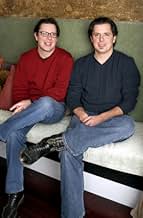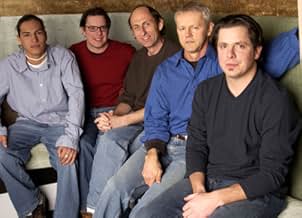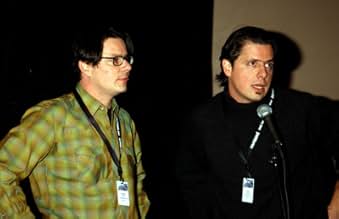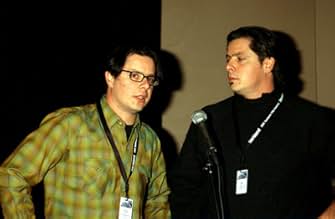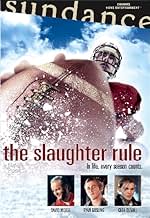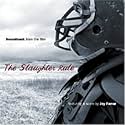IMDb RATING
5.9/10
2.8K
YOUR RATING
A young man finds solace with a young woman, his mother, and a high-school football coach who recruits him to quarterback a six-man team.A young man finds solace with a young woman, his mother, and a high-school football coach who recruits him to quarterback a six-man team.A young man finds solace with a young woman, his mother, and a high-school football coach who recruits him to quarterback a six-man team.
- Directors
- Writers
- Stars
- Awards
- 2 wins & 2 nominations total
John Henry Marshall
- Matt Kibbs
- (as John Henry Marshall III)
- Directors
- Writers
- All cast & crew
- Production, box office & more at IMDbPro
Featured reviews
Needs to be subtitled sometimes, t'was either the accent or the poor sound system. Unfortunately I'm not into any kind of sport so that does not help but now know a little bit more about American football. A good first time effort.
Ok, so I saw this movie at this year's Sundance, and I was sorely unimpressed. It took a good fifteen minutes of footage before there was an edit or a line of dialogue that made any sense, and it took another 30 minutes before the ham-fisted script gave way to a working plot that wasn't contingent on a close-up of Ryan Gosling's smile or contrived moralizing. After the first 45 minutes however, the script blossomed into a watch-able albeit not completely entertaining or thought-provoking. The highlights certainly include both Gosling and Morse's acting, Gosling being an up-and-coming star, and Morse being an extremely well-established character actor with a good feel for disparate emotions. As a sidenote, after the screening I was talking a little smack about the movie to some of my friends when David Morse walked right behind me--He looks like the nicest guy in the world, but he's a solid 6'2" and probably outweighs me by 50 pounds. I removed my foot from my mouth and promptly changed the subject.
"The Slaughter Rule" is an interesting, moving study of male relationships, with the movie portraying how the limits of male bonding are tested through past and natural emotion. Ryan Gosling is deep and effective as a teenage jock who's life has seen it's rocky roads, and then he meets a quiet, mystifying older man who wants to recruit him for a six man football team. What Gosling doesn't know is about the Man's past, which turns out to test their growing relationship. It's an often slow but alluring tale, absorbing you in to the story of characters that are both familiar and alien, and ending up with an odd but truthful ending that pulls out all the raw, closeted emotions that the two men have for each other, and it's home-movie-style video shoot and beautiful country scenery brings it to life.
Despite the novelty of its setting, 'The Slaughter Rule' is a fairly conventional coming-of-age tale about a boy who grows into manhood by becoming a member of a ragtag six-man football team. Roy is a teenager trapped in a small Montana town whose life has not been going any too well of late. His father, with whom he had only the most casual of relationships, has been discovered dead on a railroad track, a possible suicide victim. His mother, embittered by their divorce, sleeps around with countless men and has no real inclination to provide her son with any but the most cursory form of maternal affection. On top of all this, Roy has just been rejected for the school's varsity football team because the coach finds him lacking in the kind of 'anger' he feels a player needs to be a success on the gridiron. When Roy is asked by Gid, a somewhat eccentric older man in the town, to come join his six-man football team, the youth only reluctantly acquiesces (six-man football is a near rule-less poor relation to the real game, one ostensibly only played by farm boys). It is at this point that Roy's growth into manhood begins, since it turns out that the enigmatic Gid, who one assumes will be merely a father figure for the affection-starved youth, may be seeking more than just a father/son, athlete/coach relationship with the boy.
This latent-homosexual subtext, in fact, is just about the only element that separates 'The Slaughter Rule' from countless other films in this genre. Most everything else about the film feels derivative and stale: the emotionally distant parents, the promiscuous, psychologically detached mother, the abusive stepdad, the sweet girl who wants to flee this hicksville town as fast and as far as a bus ticket can take her. Towards the end, especially, the filmmakers start to pile up the heartbreaks and tragedies, one on top of the other, almost to epic proportions. One wonders how so much can happen in so short a time to so small a group of people. In the almost two hour running time of the film, only the ambiguity of the Roy/Gid relationship arouses any real interest in the viewer.
Ryan Gosling is tremendously appealing as the troubled Roy, and David Morse (the father in 'Contact') turns Gid into a nicely sympathetic figure. The starkness of the Montana landscape also provides an appropriate backdrop for the bleak melodrama that is playing itself out in the foreground. Apart from these few quality elements, however, there isn't a whole lot else to commend in 'The Slaughter Rule.'
This latent-homosexual subtext, in fact, is just about the only element that separates 'The Slaughter Rule' from countless other films in this genre. Most everything else about the film feels derivative and stale: the emotionally distant parents, the promiscuous, psychologically detached mother, the abusive stepdad, the sweet girl who wants to flee this hicksville town as fast and as far as a bus ticket can take her. Towards the end, especially, the filmmakers start to pile up the heartbreaks and tragedies, one on top of the other, almost to epic proportions. One wonders how so much can happen in so short a time to so small a group of people. In the almost two hour running time of the film, only the ambiguity of the Roy/Gid relationship arouses any real interest in the viewer.
Ryan Gosling is tremendously appealing as the troubled Roy, and David Morse (the father in 'Contact') turns Gid into a nicely sympathetic figure. The starkness of the Montana landscape also provides an appropriate backdrop for the bleak melodrama that is playing itself out in the foreground. Apart from these few quality elements, however, there isn't a whole lot else to commend in 'The Slaughter Rule.'
Sometimes technical flaws can get in the way of what otherwise could have been a good story. These movie's flaws prevented me from enjoying it much.
First, two key deleted scenes from the start of the film leave the entire premise feeling hollow. The scenes are offered as a special feature on the DVD. If I were to watch this movie again, I'd play these two deleted scenes where they should have been. First, the scene deleted after the conversation about the teen's father that opens the movie. Second, just minutes later the continuation of a scene talking with the coach in his office.
This has been a growing trend, for directors to cut key scenes that explain things at the start of the movie. In at least commentary tracks directors have said they 'just wanted to get on with the movie'. Well of course they might, since they know the story intimately. The viewer won't, and could use the background to make an emotional connection to the movie. Unless the movie is past the two hour mark, why consider cutting valuable scenes?
Gosling and some of the other performances were great. Of course Gosling does great even in rotten movies like Murder By Numbers.
The wide screen was an overly wide aspect, I guess meant to highlight those beautiful outdoor scenes over the actors. It leaves barely enough room for actors' heads in places, and it made the brief shower scene no fun at all. To echo another comment, the sound was very poor in places. More than accents, it was bad mixing where sound jumped from soft whisphers to loud music then back. My finger ended up fiddling with the volume throughout.
In hindsight, I might watch The Slaughter Rule once, but it won't be worth watching even a second time.
First, two key deleted scenes from the start of the film leave the entire premise feeling hollow. The scenes are offered as a special feature on the DVD. If I were to watch this movie again, I'd play these two deleted scenes where they should have been. First, the scene deleted after the conversation about the teen's father that opens the movie. Second, just minutes later the continuation of a scene talking with the coach in his office.
This has been a growing trend, for directors to cut key scenes that explain things at the start of the movie. In at least commentary tracks directors have said they 'just wanted to get on with the movie'. Well of course they might, since they know the story intimately. The viewer won't, and could use the background to make an emotional connection to the movie. Unless the movie is past the two hour mark, why consider cutting valuable scenes?
Gosling and some of the other performances were great. Of course Gosling does great even in rotten movies like Murder By Numbers.
The wide screen was an overly wide aspect, I guess meant to highlight those beautiful outdoor scenes over the actors. It leaves barely enough room for actors' heads in places, and it made the brief shower scene no fun at all. To echo another comment, the sound was very poor in places. More than accents, it was bad mixing where sound jumped from soft whisphers to loud music then back. My finger ended up fiddling with the volume throughout.
In hindsight, I might watch The Slaughter Rule once, but it won't be worth watching even a second time.
Did you know
- TriviaScreenplay was developed in the Sundance Lab.
- GoofsThe microphone that the yodeling band gather round is a Sennheiser MD441, which has a tight, end-on pickup pattern. Singing into it sideways as they are, the would hardly have been picked up.
- Quotes
Roy Chutney: My father told me if I was hard enough, I wouldn't break. He lied. Everything breaks.
- ConnectionsFeatured in The 2003 IFP Independent Spirit Awards (2003)
- How long is The Slaughter Rule?Powered by Alexa
Details
Box office
- Budget
- $500,000 (estimated)
- Gross US & Canada
- $13,411
- Opening weekend US & Canada
- $1,461
- Jan 12, 2003
- Gross worldwide
- $13,411
- Runtime1 hour 52 minutes
- Color
- Sound mix
- Aspect ratio
- 2.35 : 1
Contribute to this page
Suggest an edit or add missing content



